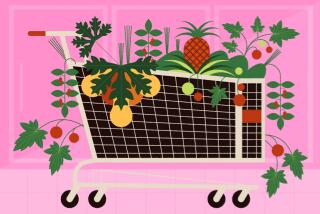Growing food without dirt? Yes, you should try it at home
- Share via
Ready to become a farmer? You can do it on a small scale — without soil.
There are three growing methods that end with “-ponics” (from Greek meaning “to labor” or “to work”):
Hydroponics: The “hydro,” or “water,” is key to growing in this form. Hydroponic farms do not use soil but do have a growing medium, such as coco coir, or coconut fiber, the material you often see as the exterior layer in open-basket hanging pots. As with aeroponics and aquaponics, the hydroponic plants need nutrients and can be grown in vertical racks or on your kitchen counter.
Aeroponics: This method does, indeed, put the air to work. Aeroponic production does not involve a growing medium; instead, roots dangle in the open air and are misted with nutrient-rich water. The plants reach maturity quickly. Although it uses significantly less water than comparable field crops, it makes having a bacteria-free environment imperative.
Aquaponics: A combination of hydroponic growing and fish (or sometimes other creatures, such as snails). Fish effluent is transformed into a nutrient for plants, then recycled back into the fish tank. At Chico State, which is developing its own aquaponics program, excrement from koi and bass provides the nutrients for the plants, which are housed in a greenhouse. Much of the Chico produce is given to a food pantry for students.
The promise of hydroponics, aeroponics and aquaponics have made cultivation of crops in controlled environments a growth industry.
A home system is likely to be labeled “hydroponic,” an umbrella term that covers all three growing methods.
You’ll find small, tabletop systems at online retailers under such brand names as VegeBox, AeroGarden, GrowLED and more. Herb and/or vegetable planters can be found for less than $100. (Smaller models are usually herbs only; larger ones may include leafy greens, cherry tomatoes, peppers or other veggies.)
If you want a fuller home system, ForkFarms offers a fourth-generation system, called the Flex Farm, that’s about the size of a refrigerator. It comes with what you’ll need to grow, including seeds as part of its starter kit, lights and a pump. Just add water. About $4,700, plus shipping and tax.
Info: bit.ly/ForkFarmsKit
More to Read
Eat your way across L.A.
Get our weekly Tasting Notes newsletter for reviews, news and more.
You may occasionally receive promotional content from the Los Angeles Times.










